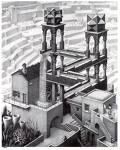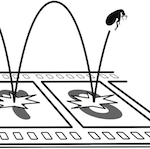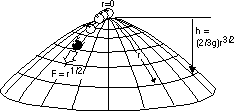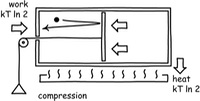


home >> lectures >> Thought Experiments, Vienna, July 2018



Download all papers linked below as a single zip file.

Tuesday, July 3, 9:00-10:20.

Download Powerpoint
How can thought experiments bring us knowledge of the world? Do they have extraordinary epistemic powers that transcend the normal limits of empiricism? This lecture will develop and defend a negative, deflationary account of thought experiments in science: they are merely picturesque arguments. They tell us only what can be learned by ordinary argumentation from what we already know. To carry out a thought experiment is to run an argument, although the picturesque setting may disguise this character.
John D. Norton, "Why
Thought Experiments Do Not Transcend Empiricism" pp. 44-66 in
Christopher Hitchcock (ed.) Contemporary Debates in the Philosophy of
Science. Blackwell, 2004.
John D. Norton, "Thought Experiments in Einstein's Work," in Thought Experiments In Science and Philosophy, eds. T. Horowitz, G. J. Massey, Savage, MD: Rowman and Littlefield, 1991.
John D. Norton, "Are Thought Experiments Just What You Thought?" Canadian Journal of Philosophy, 26 (1996), pp. 333-66.


Thursday July 5, 9:00-10:20

Download Powerpoint
Generally thought experiments in science are welcome and
lucid clarifications of some point in science, especially when their
source is Galileo and Einstein. However Galileo’s thought experiment
against the speed-distance law of fall has been decried for centuries as
flawed reasoning. Einstein’s chasing a light beam thought experiment has
similarly defied cogent explanation. There are, I believe, satisfying
readings of both, which I will present.
(The explication of the Galileo thought experiment is joint work with
Bryan Roberts.)
John D. Norton and Bryan Roberts, “Galileo's Refutation of the Speed-Distance Law of Fall Rehabilitated,” Centaurus. 54 (2012), pp. 148-164.
John D. Norton, "Chasing the Light: Einstein's Most Famous Thought Experiment," Thought Experiments in Philosophy, Science and the Arts, eds., James Robert Brown, Mélanie Frappier and Letitia Meynell, New York: Routledge, 2013. pp. 123-140.
John D. Norton, "Einstein's Special Theory of Relativity and the Problems in the Electrodynamics of Moving Bodies that Led him to it." pp. 72-102 in Cambridge Companion to Einstein, M. Janssen and C. Lehner, eds., Cambridge University Press, 2014.

Friday July 6, 9:00-10:20

Download Powerpoint
Here is a challenge to thought experimenting: How might we build in thought an infinite lottery machine? It is a device that chooses without favor among a countable infinity of outcomes, 1, 2, 3, ... The challenge proves considerably harder than one might expect. It requires us to call upon exotic processes like supertasks. The exercise proves revealing for our notions of physical possibility and in providing an instance of a stochastic system that cannot be analyzed probabilistically.
John D. Norton, "How to Build an Infinite Lottery Machine," European Journal for Philosophy of Science, 8 (2018), pp. 71-95.
John D. Norton and Alexander R. Pruss, "Correction to John D. Norton 'How to Build an Infinite Lottery Machine,' ” European Journal for Philosophy of Science. 8 (2018), pp. 143-44.
John D. Norton "How NOT to Build an Infinite Lottery Machine," manuscript.
John D. Norton, "Infinite Lottery Machines," Chapter 13 in The Material Theory of Induction. Book manuscript available online.

Friday July 6, 14:00-15:20

Download Powerpoint
It is an apparently innocuous Newtonian system. A point mass sits exactly at the symmetrical apex of a dome. What happens next? One solution of Newton's equations of motion is that the mass stays exactly where it is, for ever. However other solutions allow the mass to move spontaneously in any direction at any later time. Is this indeterminism in a simple Newtonian system? I think so. Others have disagreed and the ensuing debate has raised questions about what counts as a Newtonian system, what idealizations are admissible in them and whether the dome contravenes the physicists' idea of what is admissible physically.
John D. Norton, "The Dome: An Unexpectedly Simple Failure of Determinism" Proceedings of the 2006 Biennial Meeting of the Philosophy of Science Association, Philosophy of Science, 75, No. 5, (2008). pp. 786-98.
John D. Norton, "Indeterministic Physical Systems," Chapter 15 in The
Material Theory of Induction. Book manuscript available online.

Thought experiments in science are usually helpful or at least unproblematic. This lecture describes an exception. In Szilard's 1929 thought experiment, a Maxwell's demon manipulates a one-molecule gas. This flawed thought experiment has supported decades of muddled thinking on a connection between information and thermodynamic entropy. I diagnose how it does this by its misuse of narrative conventions granted thought experimenters. It is the worst thought experiment in science, both for its misuse of the medium and the lingering confusion it has caused.
John D. Norton "The Worst Thought Experiment," Eds. Michael T. Stuart, James Robert Brown, and Yiftach Fehige. London: Routledge, 2018. pp. 454-68.
For more, see my page on thought experiments.